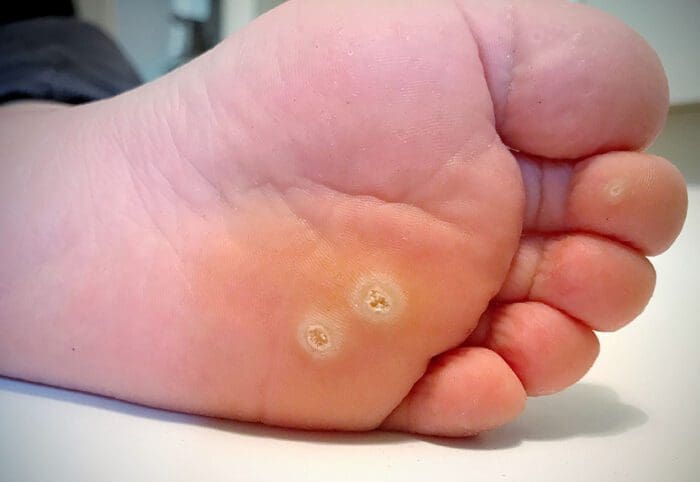
Published: September 09, 2020
Plantar Warts
What is a Plantar Wart?
Plantar Warts are small bumps on the skin that are caused by the human papillomavirus (HPV). Plantar warts, also called verruca vulgaris, typically appear on the bottom of the foot (plantar side), but can appear anywhere on the foot.

Who Can Get Warts?
Anyone can develop plantar warts, but they are most likely to affect:
- Children from the age of 5-18
- The elderly
- People with weak immune systems
Adults can also get plantar warts, especially if they have had plantar warts before.
How Did I Get a Wart?
Plantar warts are very common and are most frequently transmitted by:
- Casual skin contact
- Shared items, such as shoes, washcloths, or towels
- Walking barefoot in public areas, including: hotel rooms, public showers, locker rooms, pools, and water parks
Each person’s immune system reacts differently to HPV, so not everyone who comes in contact with the virus will develop warts. It may even take months for the wart to appear on your skin after you have come into contact with the virus.
Common Features of Warts:
- Flesh colored, pink, or white
- Rough, bumpy surface
- Small black dots
- Single wart or multiple
- Raised or flat
Prevention
- Wear shoes or sandals in public environments: locker rooms, hotel rooms, the pool, etc.
- Don’t pick at your wart, this could cause the wart to spread
Treatment
Home Care:
- Over the counter topical acids like Compound W®
- Freezing spray typically does not work on plantar warts

When to Seek Professional Care?
- When the wart causes pain, discomfort, or affects daily life
- When the wart changes, increases in size, or spreads
- When over the counter products do not work
- When you notice bleeding or signs of infection around the wart
- When you have diabetes and have warts on your feet
What to Expect at Your Appointment
The podiatrist will select the best treatment for the patient after reviewing history and conducting a physical exam. Then, the raised skin of the wart is removed. Next, the podiatrist will apply a special acid to the wart. The application of the acid is a painless process. It often takes multiple visits to destroy a wart and it is not typical to have to “cut out” a wart.
Did You Know?
- In Ohio, a podiatrist can treat warts on the feet and hands
- Podiatrists are professionally trained to treat warts